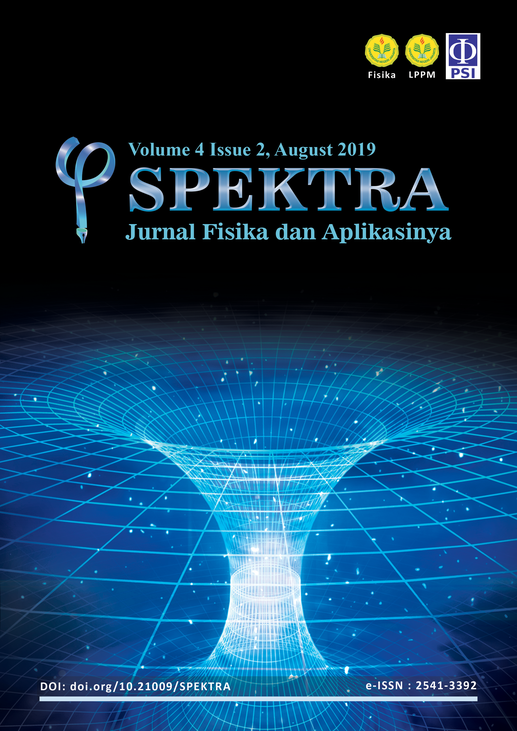OPTIMIZATION OF THE USE OF FLY ASH AS AN ADDITIVE PORTLAND COMPOSITE CEMENT (PCC)
DOI:
https://doi.org/10.21009/SPEKTRA.042.02Keywords:
Lahat fly ash, PCC cement, the chemical quality of cement, physical quality of cementAbstract
Research has been carried out on the optimization of the use of Lahat Fly Ash as an Additive Portland Composite Cement (PCC) which aims to determine the optimum conditions for adding Lahat fly ash to produce cement with physical and chemical requirements in accordance with SNI 7064:2014 and discover the ideal composition of cement with fly additions Lahat ash from various cement compositions. The quality analysis in making PCC cement is chemically in the form of Insoluble Residue (IR), Loss of Ignition (LOI), and free lime (FCaO) as well as the quality of physics in the form of Blaine, setting time, and cement mortar compressive strength. The results obtained after the process of making PCC cement with the addition of 14% Lahat fly ash, namely PCC cement in optimum conditions with physical and chemical requirements in accordance with SNI 7064: 2014 where the ideal composition of PCC cement manufacture is 14% Lahat fly ash, clinker 62%, 3% gypsum, 18% limestone, and 3% pozzolans in making PCC cement. Therefore, Lahat fly ash can be used as an alternative mixture in making PCC cement.
References
[2] Ministry of Energy and Mineral Resources of the Republic of Indonesia. 2018. 2017 Results and Outlook 2018 Mineral and Coal Subsectors. Available: http://esdm.go.id/.
[3] Regulation of Government Regulation No. 18 of 1999 concerning Management of Hazardous and Toxic Waste.
[4] S. P. R. Wardani, “Utilization of Fly Ash for Soil Stabilization and Other Civil Engineering Purposes in Reducing Environmental Pollution,” Journal: Faculty of Engineering, 2008.
[5] P. Nugraha and Antoni, “Concrete Technology,” Yogyakarta: Andi Offset, 2004.
[6] M. Farhan, “Addition of Coal Ash as a Mixed Material for Cement Making Process,” Thesis, Palembang: Sriwijaya Polytechnic, 2016.
[7] National Standardization Agency, SNI 7064:2014, Portland Composite Cement, Jakarta.
[8] J. B. Hariawan, “Effect of Differences in the Characteristics of Cement Ordinary Portland Cement (OPC) and Portland Composite Cement (PCC) Type on Mortar Compressive Strength,” Essay, West Java: Gunadarma University, 2007.
[9] N. Dahliar,, S. Widodo and A. Tonggiroh, “Effect of Coal Ash Composition on Portland Cement Clinker Quality at PT Semen Tonasa Unit III,” Journal of Geoscience, Vol. 10. No. 02. Pp. 59-60, 2014.
[10] National Standardization Agency, SNI 2049:2015, Portland Cement, Jakarta.
[11] Hargono, M. Jaeni and F. S. Budi, “Effects of Comparison of Pozolan Cement and Portland Cement Against Form Conservation and Cement Press Strength,” Journal of the Chemical Engineering Department, Faculty of Engineering, 2003.
[12] T. Ningsih, R. Chairunnisa and S. Miskah, “Material Utilization of Rice Husk Ash Additive at Cement Portland PT Semen Baturaja (Persero) Tbk.,” Journal of Chemical Engineering, Vol. 18. No. 4. Pp 59-66, 2012.
Downloads
Published
How to Cite
Issue
Section
License
SPEKTRA: Jurnal Fisika dan Aplikasinya allow the author(s) to hold the copyright without restrictions and allow the author(s) to retain publishing rights without restrictions. SPEKTRA: Jurnal Fisika dan Aplikasinya CC-BY or an equivalent license as the optimal license for the publication, distribution, use, and reuse of scholarly work. In developing strategy and setting priorities, SPEKTRA: Jurnal Fisika dan Aplikasinya recognize that free access is better than priced access, libre access is better than free access, and libre under CC-BY or the equivalent is better than libre under more restrictive open licenses. We should achieve what we can when we can. We should not delay achieving free in order to achieve libre, and we should not stop with free when we can achieve libre.
 SPEKTRA: Jurnal Fisika dan Aplikasinya is licensed under a Creative Commons Attribution 4.0 International License.
SPEKTRA: Jurnal Fisika dan Aplikasinya is licensed under a Creative Commons Attribution 4.0 International License.
You are free to:
Share - copy and redistribute the material in any medium or format
Adapt - remix, transform, and build upon the material for any purpose, even commercially.
The licensor cannot revoke these freedoms as long as you follow the license terms.

 E-ISSN 2541-3392
E-ISSN 2541-3392  Focus & Scope
Focus & Scope  Editorial Team
Editorial Team  Reviewer Team
Reviewer Team  Author Guidelines
Author Guidelines  Article Template
Article Template  Author Fee
Author Fee  Publication Ethics
Publication Ethics  Plagiarism Policy
Plagiarism Policy  Open Access Policy
Open Access Policy  Peer Review Process
Peer Review Process  Retraction & Correction
Retraction & Correction  Licensing & Copyright
Licensing & Copyright  Archiving & Repository
Archiving & Repository  Contact
Contact  Mendeley
Mendeley 

